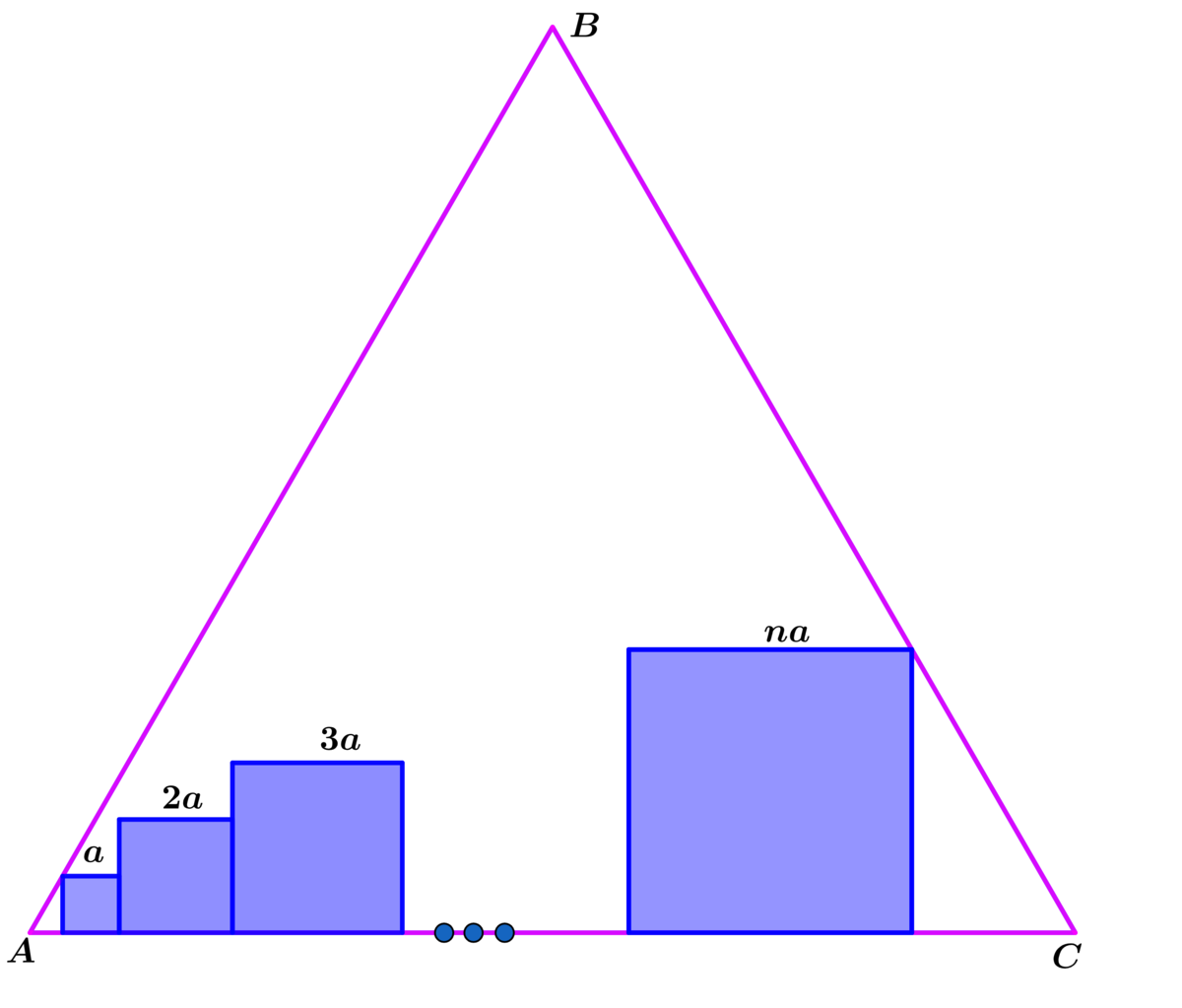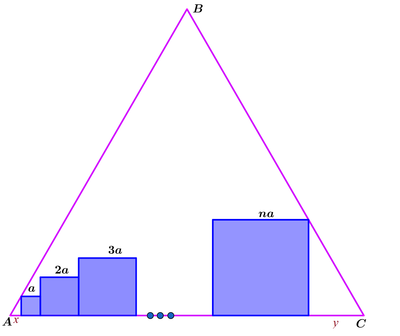It's All Squares 2

Let n be a positive integer.
Equilateral △ A B C has a side length of 1 and the n inscribed squares have side lengths a , 2 a , . . . n a as shown above.
Let A T be the total area of the n squares.
Find the value of n for which a A T = 1 1 3 1 8 ( 2 3 − 1 ) .
The answer is 4.
This section requires Javascript.
You are seeing this because something didn't load right. We suggest you, (a) try
refreshing the page, (b) enabling javascript if it is disabled on your browser and,
finally, (c)
loading the
non-javascript version of this page
. We're sorry about the hassle.
2 solutions
Interesting - the ratio a 2 n A T tends to a nice limit as n → ∞ .

Let the two ends of line A C not covered by the bases of squares be x and y as shown in the figure. Then x = a cot 6 0 ∘ = 3 a and y = n a cot 6 0 ∘ = 3 n a . From A C = 1 , we have:
3 a + a + 2 a + 3 a + ⋯ + n a + 3 n a 3 a + 2 n ( n + 1 ) a + 3 n a ( n + 1 ) ( 2 n + 3 1 ) a 2 3 ( n + 1 ) ( 3 n + 2 ) a ⟹ a = 1 = 1 = 1 = 1 = ( n + 1 ) ( 3 n + 2 ) 2 3
Now we have A T = a 2 + ( 2 a ) 2 + ( 3 a ) 2 + ⋯ + ( n a ) 2 = 6 n ( n + 1 ) ( 2 n + 1 ) a 2 . And
a A T 6 n ( n + 1 ) ( 2 n + 1 ) a 6 n ( n + 1 ) ( 2 n + 1 ) ⋅ ( n + 1 ) ( 3 n + 2 ) 2 3 3 ( 3 n + 2 ) n ( 2 n + 1 ) 3 n + 2 3 n ( 2 n + 1 ) ⟹ n = 1 1 3 1 8 ( 2 3 − 1 ) = 1 1 3 ( 2 3 + 1 ) 1 8 ( 2 3 − 1 ) ( 2 3 + 1 ) = 1 1 ( 6 + 3 ) 1 8 ⋅ 1 1 = 6 + 3 1 8 = 1 2 + 2 3 3 6 = 4
tan ( 6 0 ∘ ) = 3 = x a ⟹ x = 3 a
and
tan ( 6 0 ∘ ) = 3 = y n a ⟹ y = 3 n a
⟹ a ( 3 n + 1 + 2 n ( n + 1 ) ) = 1 ⟹ a ( n + 1 ) ( 2 + 3 n ) = 2 3
⟹ a = ( n + 1 ) ( 2 + 3 n ) 2 3
⟹
A T = a 2 ∑ j = 1 n j 2 = a 2 6 n ( n + 1 ) ( 2 n + 1 ) ⟹
a A T = a 6 n ( n + 1 ) ( 2 n + 1 ) = 3 ( 2 + 3 n ) n ( 2 n + 1 ) = 1 1 3 1 8 ( 2 3 − 1 )
⟹ 1 1 n ( 2 n + 1 ) = 1 8 ( 2 3 − 1 ) ( 2 + 3 n )
⟹ 2 2 n 2 + 1 1 n = 1 8 ( 4 3 − 2 ) + 1 8 ( 6 − 3 ) n ⟹
2 2 n 2 − ( 9 7 − 1 8 3 ) n − ( 7 2 3 − 3 6 ) = 0 ⟹ n = 4 , n = − 2 2 9 ( 2 3 − 1 )
Since n is a positive integer we choose n = 4